Friday, February 17
• The Big Dipper stands on its handle in the northeast around 9 p.m. In the northwest, Cassiopeia also stands on end at about the same height. As spring approaches, the Dipper will rise higher and Cassiopeia will move lower.
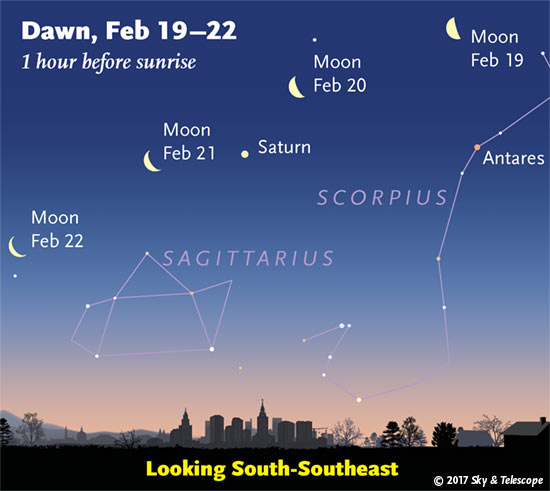
Saturday, February 18
• Last-quarter Moon (exact at 2:33 p.m.). Before dawn on Sunday the 19th, look for the Moon in the south-southeast, as shown here. Antares and upper Scorpius are below and to the lower right of it, respectively. Saturn is farther to the Moon's lower left.
Sunday, February 19
• On Monday and Tuesday mornings the 20th and 21st, you'll find Saturn glowing steadily near the waning Moon, as shown here.
• This is the time of year when Orion stands highest in early evening. So does Lepus the Hare under his feet! Explore the telescopic deep-sky sights around Lepus's ears (just below Rigel) with Sue French's Deep-Sky Wonders article, chart and photos in the February Sky & Telescope, page 54.
Monday, February 20
• Right after dark this week, bright Capella crosses near the zenith. Face northwest at that time and look 20° down from Capella. The brightest star there is Alpha Persei (Mirfak). Around and upper left of it is the Perseus OB1 Association, a loose swarm of modestly bright stars about the size of your thumbtip at arm's length. They show well in binoculars.
• Ten degrees north of Alpha Persei, and 8° west of the Perseus Double Cluster, is an interesting binocular star cluster that wasn't even recognized as such until the mid-1950s. It wasn't brought to amateurs' attention until 1977 (though some of us had noticed it independently!). Today it's known as Pazmino's Cluster, a.k.a. Stock 23. See Mathew Wedel's Binocular Highlight column and chart for this and other clusters overshadowed by the famous Double Cluster in the February Sky & Telescope, page 43.
Tuesday, February 21
• This is a fine week to look for the zodiacal light if you live in the northern latitudes, now that the evening sky is moonless and the ecliptic tilts high upward from the west horizon at nightfall. From a clear, clean, wide-open dark site, look west at twilight's very end for a vague but huge, tall pyramid of pearly light. It's tilted to the left, aligning along the constellations of the zodiac: through Venus and up between Aldebaran and the Pleiades.
What you're seeing is sunlit interplanetary dust orbiting the Sun near the ecliptic plane. Believe it or not, seen from interstellar distances this would be the solar system's brightest feature after the Sun itself. The "zodiacal lights" of dust around other stars may be a real obstacle to someday seeing their small, terrestrial planets.
Wednesday, February 22
• Carnivores emerge from hibernation. After dinnertime at this time of year, five carnivore constellations are rising upright in a ragged row from the northeast to south. They're all seen in profile with their noses pointed up and their feet (if any) to the right. These are Ursa Major in the northeast (with the Big Dipper as its brightest part), Leo in the east, Hydra the Sea Serpent in the southeast, Canis Minor higher in the south-southeast, and bright Canis Major in the south.
• Algol should be at minimum light, magnitude 3.4 instead of its usual 2.3, for a couple hours centered on 9:39 p.m. EST. It takes several more hours before and after to fade and rebrighten. Comparison-star chart, with star magnitudes given to the nearest tenth.
Thursday, February 23
• Certain deep-sky objects contain secret surprises within or near them. Get out your telescope and sky atlas for a go at Bob King's eight Hidden Gems in Common Deep-Sky Objects now in evening view. One example is the planetary nebula inside the open cluster M46, east of Sirius.
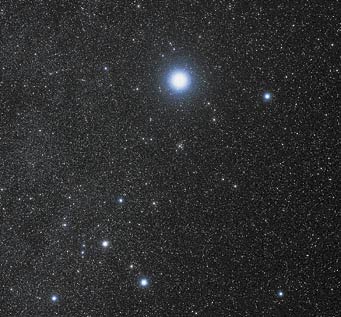
Akira Fujii
Friday, February 24
• Sirius blazes high in the south on the meridian by about 8 or 9 p.m. now. Using binoculars, examine the spot 4° south of Sirius (directly below it when on the meridian). Four degrees is somewhat less than the width of a typical binocular's field of view. Can you see a dim little patch of speckly gray haze? That's the open star cluster M41, about 2,200 light-years away. Sirius, by comparison, is only 8.6 light-years away.
Saturday, February 25
• Have you ever seen Canopus, the second-brightest star after Sirius? In one of the many interesting coincidences that devoted skywatchers know about, Canopus lies almost due south of Sirius: by 36°. That's far enough south that it never appears above your horizon unless you're below latitude 37° N (southern Virginia, southern Missouri, central California). And there, you'll need a very flat south horizon. Canopus crosses due south just 21 minutes before Sirius does.
When to look? Canopus is due south when Beta Canis Majoris — Mirzam the Announcer, the star about three finger-widths to the right of Sirius — is at its highest point due south (roughly 8:00 p.m. now, depending on how far east or west you are in your time zone). Look straight down from Mirzam then. It's the brightest star to the right of Sirius in the photo above.
• Tomorrow February 26th, an annular eclipse of the Sun will cross parts of southernmost South America, the South Atlantic, and east-central Africa. A partial eclipse will be seen over much larger areas of South America and Africa. Map and details.
_________________________
Want to become a better astronomer? Learn your way around the constellations! They're the key to locating everything fainter and deeper to hunt with binoculars or a telescope.
This is an outdoor nature hobby. For an easy-to-use constellation guide covering the whole evening sky, use the big monthly map in the center of each issue of Sky & Telescope, the essential guide to astronomy.
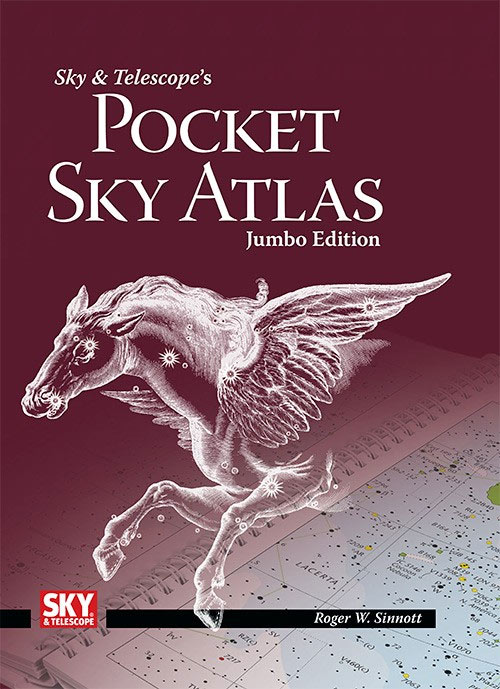
Once you get a telescope, to put it to good use you'll need a detailed, large-scale sky atlas (set of charts). The basic standard is the Pocket Sky Atlas (in either the original or Jumbo Edition), which shows stars to magnitude 7.6.
Next up is the larger and deeper Sky Atlas 2000.0, plotting stars to magnitude 8.5; nearly three times as many. The next up, once you know your way around, is the even larger Uranometria 2000.0 (stars to magnitude 9.75). And read how to use sky charts with a telescope.
You'll also want a good deep-sky guidebook, such as Sue French's Deep-Sky Wonders collection (which includes its own charts), Sky Atlas 2000.0 Companion by Strong and Sinnott, or the bigger Night Sky Observer's Guide by Kepple and Sanner.
Can a computerized telescope replace charts? Not for beginners, I don't think, and not on mounts and tripods that are less than top-quality mechanically (meaning heavy and expensive). And as Terence Dickinson and Alan Dyer say in their Backyard Astronomer's Guide, "A full appreciation of the universe cannot come without developing the skills to find things in the sky and understanding how the sky works. This knowledge comes only by spending time under the stars with star maps in hand."
This Week's Planet Roundup

Mercury is hidden deep in the glare of sunrise.
Venus dazzles in the west-southwest during twilight, then lower in the west after dark. Venus is at its peak brightness, magnitude –4.8, all February. Upper left of it is tiny orange Mars, only 0.4% as bright.
In a telescope Venus is a crescent, thinning and enlarging week by week. It's now about 41 arcseconds from cusp to cusp and 24% sunlit. For the rest of the winter, as Venus swings toward us, it will continue to expand as its phase wanes down to a super-thin crescent.
Venus in a telescope is least glary when viewed in bright twilight. So get your scope on it as soon as you can see it naked-eye, even before sunset.
Mars (magnitude +1.2) is the faint "star" upper left of Venus. They widen from 8° to 10° apart this week. In a telescope Mars is just a tiny fuzzblob 5 arcseconds across.
Vesta, the brightest asteroid, is visible in binoculars at magnitude 6.8 as it moves through Gemini near Pollux and Castor. Article and finder chart.
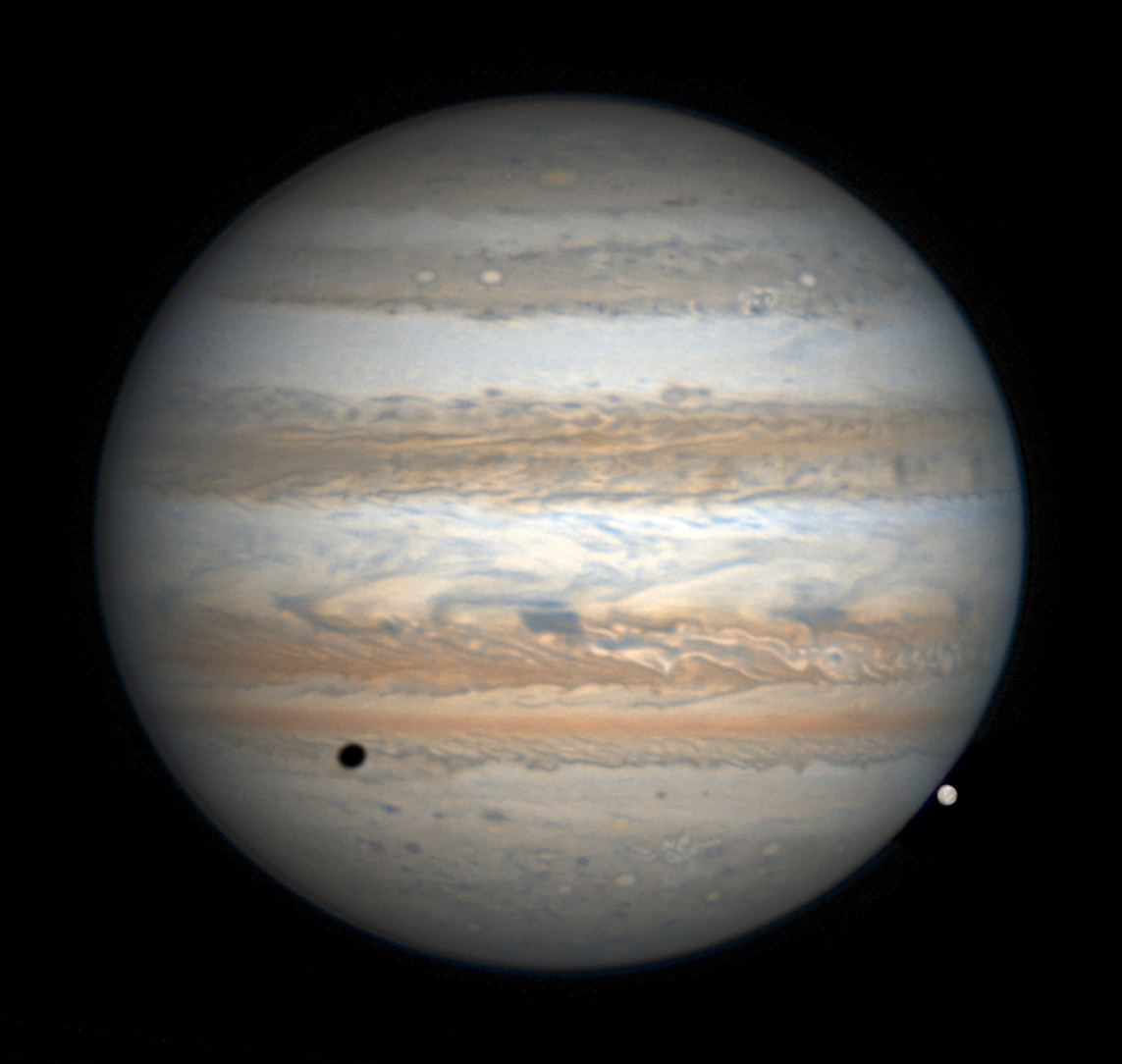
Jupiter (magnitude –2.3, in Virgo) rises around 9 or 10 p.m. and glares highest in the south in the hours before dawn. Spica dangles not quite 4° lower right of it after they rise, more directly below it in the early-morning hours, and lower left of it in early dawn as shown above. Jupiter is creamy white; Spica is an icier shade of white with a trace of blue (once it's fairly high).
In a telescope Jupiter is 41 arcseconds across its equator, on its way to 44 arcseconds in the weeks around its April 7th opposition.
Saturn (magnitude +0.5, on the Ophiuchus-Sagittarius border) rises in the early morning hours and glows in the southeast before and during dawn. Redder Antares, magnitude +1.0, twinkles 17° to Saturn's right.
Uranus (magnitude 5.9, in Pisces) is still in view in the southwest right after dark, in the background of Mars. The two planets will pass 0.6° from each other on the evening of February 26th. Finder chart showing Uranus among its background stars (without Mars).
Neptune is lost in the glow of sunset.
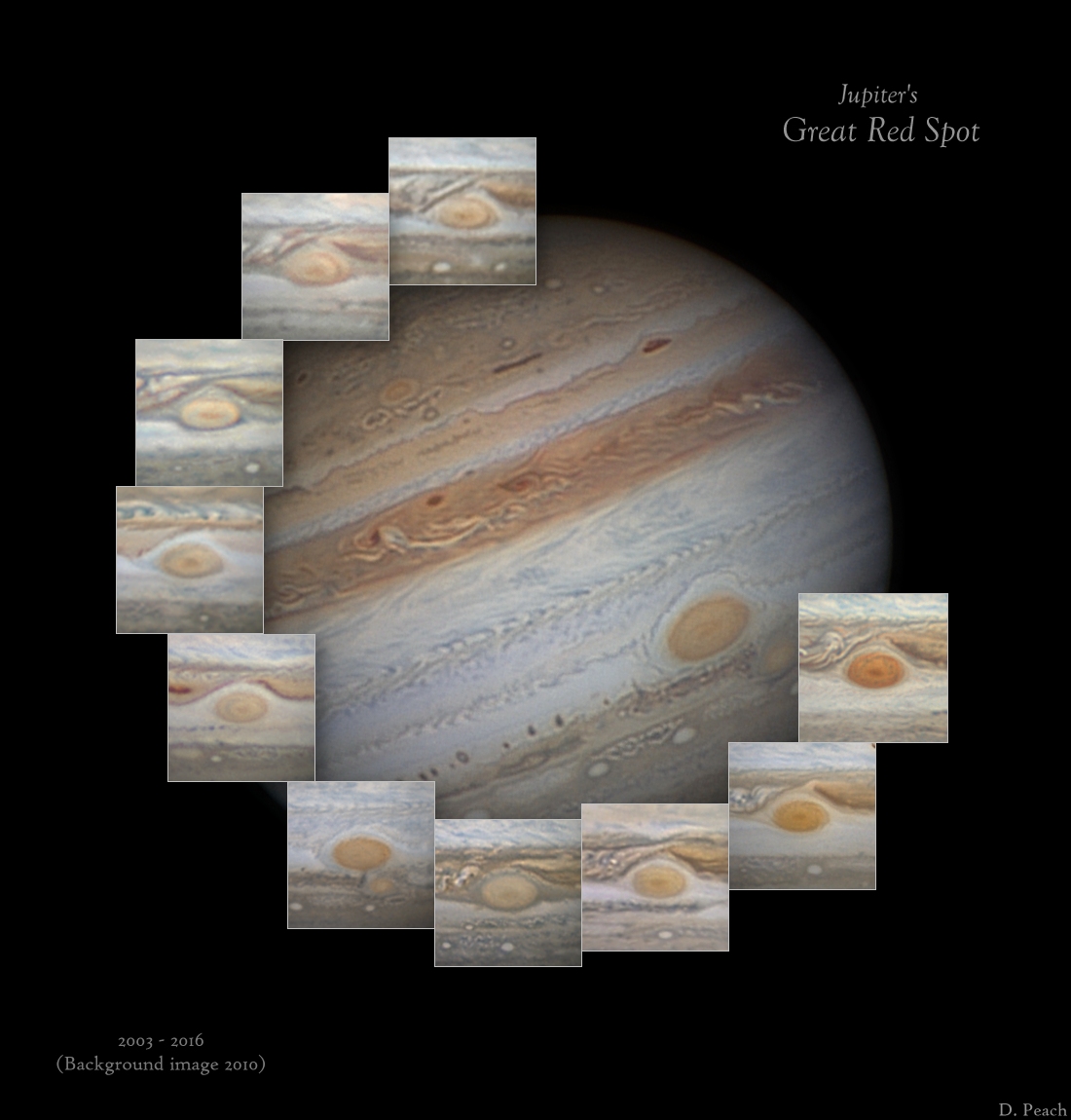
__________________________
All descriptions that relate to your horizon — including the words up, down, right, and left — are written for the world's mid-northern latitudes. Descriptions that also depend on longitude (mainly Moon positions) are for North America.
Eastern Standard Time (EST) is Universal Time (UT, UTC, or GMT) minus 5 hours.
__________________________
"This adventure is made possible by generations of searchers strictly adhering to a simple set of rules. Test ideas by experiments and observations. Build on those ideas that pass the test. Reject the ones that fail. Follow the evidence wherever it leads, and question everything. Accept these terms, and the cosmos is yours."
— Neil deGrasse Tyson, 2014
"Objective reality exists. Facts are often determinable. Science and reason are no political conspiracy; they are how we discover objective reality. Civilization's survival depends on our ability, and willingness, to do this."
— Alan MacRobert, your Sky at a Glance editor
"Facts are stubborn things."
— John Adams, 1770
March For Science on April 22nd, to “champion publicly funded and publicly communicated science as a pillar of human freedom and prosperity.”
 4
4








Comments
thomas-ryan
February 17, 2017 at 11:43 am
I'm glad this is moderated because it is maybe not exactly on topic, but I have a question. The 2017 eclipse. I am hosting an event. I want to tell my guests What night and what time to look at the sky this spring that will match the sky as revealed by the eclipse. 1PM August 21, 6 months later = 1AM Feb 21, = 9PM April 15? That's my opinion, but I'm a rank amateur and would value more expert advice. I know this is out of title, but I would surely value your opinion and it might be an interesting tidbit for other readers. Most sincerely, Tom Ryan, [email protected]
You must be logged in to post a comment.
Anthony Barreiro
February 17, 2017 at 3:54 pm
Tom, that's a great idea. Where will you be observing from? That will determine how far the Sun has moved west in the sky, and how high the Sun has risen, at your time of the total eclipse.
On August 21, 2017 the Sun will be at 10 hours 04 minutes right ascension and 12 degrees north declination. So the Sun will be in the constellation Leo, just a few degrees west of the bright star Regulus. You could use a planetarium app or an online planetarium program to see where the Sun and Regulus will be at the time of the eclipse for your location (sometime between 10:00 am PDT on the coast of Oregon and 3:00 pm EDT on the coast of South Carolina), and then play around to see when Regulus will be in about the same place in the sky at a congenial nighttime hour from your location.
A very useful rule of thumb is that all the stars appear in the same place in the sky two hours earlier from one month to the next. So if you're observing from Oregon, counting backwards two hours per month from 10 am PDT on August 21 will get you to 9 pm PST on February 21, or 12 "midnight" PDT on March 21. If you're observing from South Carolina, 5 am EDT on March 21 would correspond to 3 pm EDT on August 21.
Also of interest is that the Sun will be at the same declination, and so following the same course through your daytime sky, on April 21 as on August 21.
You must be logged in to post a comment.
Anthony Barreiro
February 23, 2017 at 5:53 pm
You could also use a cardboard planisphere, like the one that Sky and Telescope sells, instead of a digital planetarium program. Put Regulus in the right place in the sky, look around the outer edge of the planisphere to find a congenial nighttime hour, and see what date the sky will look like that at that hour.
You must be logged in to post a comment.
Carlos Estrada
February 22, 2017 at 6:17 pm
From whom is the picture of Canis Major?
You must be logged in to post a comment.
You must be logged in to post a comment.